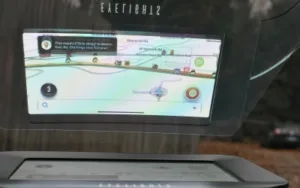The French start-up EyeLights’ first product was a monocular HUD that mounts on the inside of a motorcycle helmet and shows the rider simple instrumentation and navigation screens. The product, EyeLights Moto, delivered a clear, stable image when I held it it up to my eye. (I did not try it in a helmet, much less in a helmet while driving a motorcycle at speed.)

So far so good, but everybody and their maiden aunt in Guangzhou can make a monocular display. (If you doubt me, take a walk through South Hall at CES this coming January.) What makes this one a product rather than a component is that EyeLights Moto takes its data from Google Drive (or similar app) on the rider’s smartphone via Bluetooth and presents the information using presentation screens of its own design that are suited to the monocular’s display.
I’m personally more interested in windshield HUDs than in near-the-eye versions, and that’s what Thibaut Aglioni, EyeLights’ Content and Media Manager is emphasizing in his media tour of New York and Los Angeles during the second and third weeks of November. And so it was that Aglioni and a colleague drove into my driveway on the morning of November 12 in a rented Nissan Sentra with an EyeLights Car installed, and offered me a drive. (It sounds better in French: EyeLights Voiture.)
EyeLight Car showing a navigation screen. It was a cloudy day but not as dark as it appears in this photo, which was exposed for the display. (Photo: Ken Werner)
The EyeLights Car consists of a flat-screen monitor containing EyeLights circuitry and software that mounts to the top of the dash and a holographic screen that mounts to the windshield over the monitor. The monitor has an 8-inch IPS LCD screen with 800×480 pixels and a luminance that ranges from 30 to 4000 cd/m² nominal (4700 cd/m² max). Maximum operating temperature is 70º C (158º), which is not all that more than you need if you park your car in Arizona’s Sonoran Desert in the summer with the windows cranked up.
The monitor is 15.4 x 23.7 x 2.9 cm. The mounting plate will add to that 2.9 cm. The weight is 682 grams (1.50 pounds). The monitor must be plugged in to 12-volt power, and it connects to your smartphone via Bluetooth. Anything on your phone can be shown on the Eyelights Car, and the luminance was enough for the imager to be seen easily on a cloudy day. There are also custom screens that are generated by the EyeLights Car app. Current draw ranges from 0.3 A at minimum luminance in nightime mode to 1.7 A at maximum luminance in daytime mode, said Aglioni.
Two Modes
There are two modes, one each for night and day. Aglioni made a major issue of the windshield film’s 50-percent transparency. Despite the transparency, though, I found that I did not look past the image in either daytime or nightime mode. For me, the film might as well have been opaque, although might have been due to the product’s novelty. Incidentally, the film is opaque — and black — from the outside.
There are several products on the market that use a windshield film to reflect the image from a cell-phone screen, but the image has insufficient luminance to be a practical solution, at least during during the day. EyeLights has faced that problem directly, and with a well-thought-out implementation.
The Company
The company was founded in 2016, and launched the EyeLights Moto in 2017. After participating in the TechStars accelerator program, EyeLights closed a €2.5 million seed round in 2018. The company has its headquarters and manufacturing facilities in France, and Aglioni says they can accommodate much higher production volumes. About 2000 units each of the motorcycle and voiture products have been sold. The company has arranged with a major North American retailer for a one-month sales test, and the New York Times named the EyeLights Car one of the top 100 coolest gadgets of 2019. The company is also speaking with major European automobile manufacturers about having the EyeLights Car built into some of their vehicles. optimistic.
One of the attractions of the product as either an OEM feature or an aftermarket purchas is its affordable price. The tentative U.S. price for the monitor/film combination is $299, and $99 for a separate gesture-control device that can be mounted on the dash and used to control certain functions on your cell phone, and there for on the HUD.
Aglioni and his colleague seemed genuinely enthusiatic about the company’s progress, or maybe they just liked my driveway. (KW)
Ken Werner is Principal of Nutmeg Consultants, specializing in the display industry, manufacturing, technology, and applications, including mobile devices, automotive, and television. He consults for attorneys, investment analysts, and companies re-positioning themselves within the display industry or using displays in their products. He is the 2017 recipient of the Society for Information Display’s Lewis and Beatrice Winner Award. You can reach him at [email protected] or www.nutmegconsultants.com.

